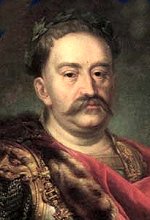 Logging in...
Logging in...
 |
Jan III Sobieski was a soldier who drove back the Ottoman Turks and briefly restored the kingdom of Poland-Lithuania to greatness for the last time. |
Jan Sobieski, called by the Turks the "Lion of Lehistan (Poland)", was born in Olesko near Lwów (now Ukrainian Lviv) in 1629. His father was a Polish-Lithuanian nobleman who ensured young Jan and his brother received a first class education. They both studied at Jagiellonian University in Krakow before Jan travelled abroad. He was well educated and toured western Europe in his youth, as was usual for a Polish noble of his class. A graduate of the Jagiellonian University where he studied philosophy, the warrior Sobieski was surprisingly educated; fluent in French, German, Italian, Latin, and Turkish.
Jan Sobieski's elder brother Mark, was his companion in arms from the time of the great Cossack rebellion (1648), and fought at Zbaraz, Beresteczko, and lastly at Batoh where, after being taken prisoner, he was murdered by the Tatars.
Jan Matejko - Sobieski At Vienna - 1883
The Battle of Vienna
The large-scale battle was won by Polish, Austrian, and German forces commanded by the King of Poland, Jan III Sobieski. They fought against the Ottoman Empire Army commanded by Grand Vizier Kara Mustafa Pasha. On this date, September 12, 1683, Central Europe was on the edge of conquest by an Islamic army. Within days, if not hours, militant and expansionist Islam would hold sway over the heart of Europe. That was when the Polish army showed up, with King Jan III Sobieski in command. The Ottoman commanders had intended to take Vienna before Sobieski arrived, but time ran out.
One of the western world's most important events took place in 1683, as a powerful Ottoman army advanced into Europe. Already having conquered Hungary and Transylvania, 138,000 Ottomans laid siege to the city of Vienna, the gateway to continental Europe. 11,000 troops and 5,000 volunteers declared that they would defend the city to the last man. For almost two months, they held out against the Turkish onslaught, suffering severe casualties as the Turks breached the outer walls of Vienna, digging tunnels and filling them with gunpowder.
Enter Jan III Sobieski, King of Poland, and the husaria, or winged hussars. As the battered Austrians prepared to fight in the streets of Vienna, Sobieski led a relief force of 30,000 Poles, 18,500 Austrians, 19,000 Franconian, Bavarian, and Swabian troops, and 9,000 Saxons. The Turks attacked the relief force, resulting in 12 hours of intense infantry combat before Sobieski saw that the time was right to break the back of the Turkish force. Sobieski led a charge of 20,000 Polish and
German cavalry, the largest cavalry charge in recorded history, with Sobieski and 3,000 winged hussars at the head of the charge. The Turkish lines crumbled, and the hussars pressed into the Turkish camps as the elated remaining defenders of Vienna poured out of the city, finally on the offensive.
The Turks retreated and abandoned their attempts to conquer Europe. Sobieski, ever the statesman, declared the following:
"Veni, vidi, Deus vicit."
I came, I saw, God conquered.
Contact Us |
About Us |
Privacy Policy |
Terms of Use |
Advertise with Us |
Press |
Quiz |
Mission Statement |
Store
©2016 Polski Domek.
